[English] 日本語
 Yorodumi
Yorodumi- PDB-1d0a: STRUCTURE OF TNF RECEPTOR ASSOCIATED FACTOR 2 (TRAF2) IN COMPLEX ... -
+ Open data
Open data
- Basic information
Basic information
| Entry | Database: PDB / ID: 1d0a | ||||||
|---|---|---|---|---|---|---|---|
| Title | STRUCTURE OF TNF RECEPTOR ASSOCIATED FACTOR 2 (TRAF2) IN COMPLEX WITH A HUMAN OX40 PEPTIDE | ||||||
 Components Components |
| ||||||
 Keywords Keywords | APOPTOSIS / B-SANDWICH / PROTEIN-PEPTIDE COMPLEX | ||||||
| Function / homology |  Function and homology information Function and homology informationTORC2 complex disassembly / CD40 receptor binding / TORC1 complex assembly / tumor necrosis factor receptor superfamily complex / sphingolipid binding / tumor necrosis factor receptor activity / TRAF2-GSTP1 complex / IRE1-TRAF2-ASK1 complex / CD27 signaling pathway / Defective RIPK1-mediated regulated necrosis ...TORC2 complex disassembly / CD40 receptor binding / TORC1 complex assembly / tumor necrosis factor receptor superfamily complex / sphingolipid binding / tumor necrosis factor receptor activity / TRAF2-GSTP1 complex / IRE1-TRAF2-ASK1 complex / CD27 signaling pathway / Defective RIPK1-mediated regulated necrosis / TNFs bind their physiological receptors / TNF receptor superfamily (TNFSF) members mediating non-canonical NF-kB pathway / CD40 signaling pathway / tumor necrosis factor binding / Regulation by c-FLIP / CASP8 activity is inhibited / Dimerization of procaspase-8 / interleukin-17-mediated signaling pathway / negative regulation of glial cell apoptotic process / TNF signaling / CD40 receptor complex / programmed necrotic cell death / Caspase activation via Death Receptors in the presence of ligand / thioesterase binding / positive regulation of tumor necrosis factor-mediated signaling pathway / tumor necrosis factor receptor binding / mRNA stabilization / regulation of immunoglobulin production / non-canonical NF-kappaB signal transduction / vesicle membrane / regulation of JNK cascade / positive regulation of extrinsic apoptotic signaling pathway / mitogen-activated protein kinase kinase kinase binding / signal transduction involved in regulation of gene expression / TNFR1-induced proapoptotic signaling / TRAF6 mediated IRF7 activation / RIPK1-mediated regulated necrosis / positive regulation of immunoglobulin production / positive regulation of JUN kinase activity / TRAF6 mediated NF-kB activation / intrinsic apoptotic signaling pathway in response to endoplasmic reticulum stress / protein K63-linked ubiquitination / ubiquitin ligase complex / regulation of protein-containing complex assembly / T cell proliferation / negative regulation of DNA-binding transcription factor activity / protein autoubiquitination / positive regulation of B cell proliferation / signaling adaptor activity / positive regulation of interleukin-2 production / cellular response to nitric oxide / response to endoplasmic reticulum stress / T cell activation / tumor necrosis factor-mediated signaling pathway / TNFR1-induced NF-kappa-B signaling pathway / Regulation of NF-kappa B signaling / TNFR2 non-canonical NF-kB pathway / Regulation of TNFR1 signaling / protein catabolic process / positive regulation of NF-kappaB transcription factor activity / positive regulation of T cell cytokine production / RING-type E3 ubiquitin transferase / Regulation of necroptotic cell death / cytoplasmic side of plasma membrane / ubiquitin-protein transferase activity / ubiquitin protein ligase activity / virus receptor activity / protein-containing complex assembly / cell cortex / protein phosphatase binding / protein-macromolecule adaptor activity / regulation of apoptotic process / positive regulation of canonical NF-kappaB signal transduction / Ub-specific processing proteases / immune response / membrane raft / inflammatory response / innate immune response / external side of plasma membrane / negative regulation of DNA-templated transcription / ubiquitin protein ligase binding / protein kinase binding / protein-containing complex binding / enzyme binding / cell surface / signal transduction / zinc ion binding / nucleoplasm / identical protein binding / plasma membrane / cytoplasm / cytosol Similarity search - Function | ||||||
| Biological species |  Homo sapiens (human) Homo sapiens (human) | ||||||
| Method |  X-RAY DIFFRACTION / X-RAY DIFFRACTION /  SYNCHROTRON / Resolution: 2 Å SYNCHROTRON / Resolution: 2 Å | ||||||
 Authors Authors | Ye, H. / Park, Y.C. / Kreishman, M. / Kieff, E. / Wu, H. | ||||||
 Citation Citation |  Journal: Mol.Cell / Year: 1999 Journal: Mol.Cell / Year: 1999Title: The structural basis for the recognition of diverse receptor sequences by TRAF2. Authors: Ye, H. / Park, Y.C. / Kreishman, M. / Kieff, E. / Wu, H. #1:  Journal: Nature / Year: 1999 Journal: Nature / Year: 1999Title: Structural Basis for Self-Association and Receptor Recognition of Human Traf2 Authors: Park, Y.C. / Burkitt, V. / Villa, A.R. / Tong, L. / Wu, H. | ||||||
| History |
|
- Structure visualization
Structure visualization
| Structure viewer | Molecule:  Molmil Molmil Jmol/JSmol Jmol/JSmol |
|---|
- Downloads & links
Downloads & links
- Download
Download
| PDBx/mmCIF format |  1d0a.cif.gz 1d0a.cif.gz | 221.6 KB | Display |  PDBx/mmCIF format PDBx/mmCIF format |
|---|---|---|---|---|
| PDB format |  pdb1d0a.ent.gz pdb1d0a.ent.gz | 176.8 KB | Display |  PDB format PDB format |
| PDBx/mmJSON format |  1d0a.json.gz 1d0a.json.gz | Tree view |  PDBx/mmJSON format PDBx/mmJSON format | |
| Others |  Other downloads Other downloads |
-Validation report
| Summary document |  1d0a_validation.pdf.gz 1d0a_validation.pdf.gz | 403 KB | Display |  wwPDB validaton report wwPDB validaton report |
|---|---|---|---|---|
| Full document |  1d0a_full_validation.pdf.gz 1d0a_full_validation.pdf.gz | 418 KB | Display | |
| Data in XML |  1d0a_validation.xml.gz 1d0a_validation.xml.gz | 22.8 KB | Display | |
| Data in CIF |  1d0a_validation.cif.gz 1d0a_validation.cif.gz | 37.6 KB | Display | |
| Arichive directory |  https://data.pdbj.org/pub/pdb/validation_reports/d0/1d0a https://data.pdbj.org/pub/pdb/validation_reports/d0/1d0a ftp://data.pdbj.org/pub/pdb/validation_reports/d0/1d0a ftp://data.pdbj.org/pub/pdb/validation_reports/d0/1d0a | HTTPS FTP |
-Related structure data
- Links
Links
- Assembly
Assembly
| Deposited unit | 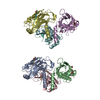
| ||||||||
|---|---|---|---|---|---|---|---|---|---|
| 1 | 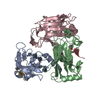
| ||||||||
| 2 | 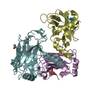
| ||||||||
| 3 | 
| ||||||||
| 4 | 
| ||||||||
| Unit cell |
|
- Components
Components
| #1: Protein | Mass: 19032.953 Da / Num. of mol.: 6 / Fragment: TRAF DOMAIN Source method: isolated from a genetically manipulated source Source: (gene. exp.)  Homo sapiens (human) / Plasmid: PET24D / Production host: Homo sapiens (human) / Plasmid: PET24D / Production host:  #2: Protein/peptide | Mass: 640.682 Da / Num. of mol.: 6 / Fragment: TRAF-BINDING SEQUENCE / Source method: obtained synthetically Details: THIS PEPTIDE WAS CHEMICALLY SYNTHESIZED. THE SEQUENCE OF THIS PEPTIDE NATURALLY OCCURS IN HUMANS (HOMO SAPIENS) References: UniProt: P43489 #3: Water | ChemComp-HOH / | Has protein modification | Y | |
|---|
-Experimental details
-Experiment
| Experiment | Method:  X-RAY DIFFRACTION / Number of used crystals: 1 X-RAY DIFFRACTION / Number of used crystals: 1 |
|---|
- Sample preparation
Sample preparation
| Crystal | Density Matthews: 2.71 Å3/Da / Density % sol: 54.67 % | |||||||||||||||
|---|---|---|---|---|---|---|---|---|---|---|---|---|---|---|---|---|
| Crystal grow | Temperature: 293 K / Method: vapor diffusion / pH: 6 Details: PEG4K, MES, PH 6.0, VAPOR DIFFUSION, temperature 293K | |||||||||||||||
| Crystal grow | *PLUS Method: unknown | |||||||||||||||
| Components of the solutions | *PLUS
|
-Data collection
| Diffraction | Mean temperature: 110 K |
|---|---|
| Diffraction source | Source:  SYNCHROTRON / Site: SYNCHROTRON / Site:  CHESS CHESS  / Beamline: A1 / Wavelength: 0.937 / Beamline: A1 / Wavelength: 0.937 |
| Detector | Type: RIGAKU RAXIS IV / Detector: IMAGE PLATE |
| Radiation | Protocol: SINGLE WAVELENGTH / Monochromatic (M) / Laue (L): M / Scattering type: x-ray |
| Radiation wavelength | Wavelength: 0.937 Å / Relative weight: 1 |
| Reflection | Resolution: 2→20 Å / % possible obs: 99.8 % / Rmerge(I) obs: 0.038 |
| Reflection shell | Highest resolution: 2 Å / Rmerge(I) obs: 0.127 / % possible all: 100 |
| Reflection shell | *PLUS % possible obs: 100 % |
- Processing
Processing
| Software |
| ||||||||||||
|---|---|---|---|---|---|---|---|---|---|---|---|---|---|
| Refinement | Resolution: 2→20 Å / Rfactor Rfree: 0.251 / Rfactor Rwork: 0.225 / Rfactor obs: 0.225 | ||||||||||||
| Refinement step | Cycle: LAST / Resolution: 2→20 Å
|
 Movie
Movie Controller
Controller


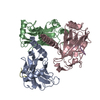


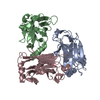



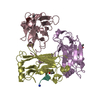

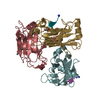
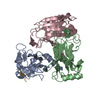
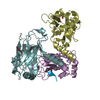
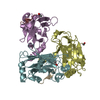
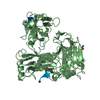
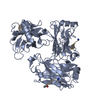
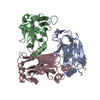
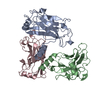
 PDBj
PDBj












